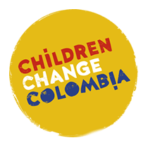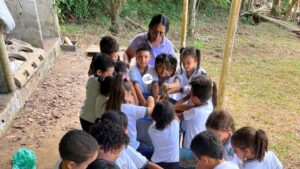María sighs, leans back in the white plastic chair, and holds her gaze, as if deciding whether it’s worth the effort to answer. Her skin is dark, and her thick afro hair is pulled into a tight ponytail that sticks straight out. Her red T-shirt and snug jeans, cinched with a brown belt, make her round figure stand out.
A warm breeze drifts through the barred window. Outside, a dusty dirt road leads down to the water, where small blue-and-white fishing boats bob gently as Caribbean waves lap the shore. Somewhere nearby, a cumbia beat plays from a radio or phone. A few adventurous tourists, straying from Santa Marta’s center, sit at makeshift beachside restaurants, eating fresh caught fish with coconut rice.
“Todo es un reto acá,” she says, her voice loud and edged with frustration. She crosses her arms over her chest.
María is costeña. Loud and direct. The kind of woman you don’t argue with, who can silence a whole classroom in an instant. Not out of fear, but because everyone knows she means business. And she’s also the one the children run to when they’re sad.

“The collaboration with parents. Or maybe just… the parents,” says María’s younger colleague, breaking a long silence as the small circle of teachers and psychologists exchange glances.
“¡Sí!” María nods firmly.
“They just can’t handle their own kids. They spend the whole day staring at their phones and drinking beer. The little ones come to me and say, ‘Look, my mom is busy dancing like this”, María half-rises from her chair and tilts her hip, moving it rhythmically up and down to demonstrate.
She nods toward the bright, colorful cut-outs figures on the wall. “Profesiones y oficios”. Beneath the sign is a police officer. A nurse. Fisherman. Baker.
“Many of them can’t find a job. Or don’t know how to keep one,” she says.
More than half the people here earn a living in the informal economy. Fishing, selling goods on the street, driving Ubers. Some work in tourism. Just outside, men lounge under palm trees in tank tops, once white, rolled up over their bellies to catch a breeze in the afternoon heat. Others doze in hammocks strung in front of their modest homes, where running water flows a few hours a day. Young mothers walk by in flip-flops, their children trailing behind, with nothing to do.
“They pick up their kids in miniskirts and bikini tops – often late. What kind of role model is that?
Many of these children haven’t even had their early childhood check-ups because the parents just can’t be bothered,” María says.
The others nod.
At this preschool, much of the day is spent helping children calm down. Their nervous systems are constantly on high alert from living in homes where violence, toxic gender norms, and poverty are part of daily life.
María knows the families here. She knows who goes hungry, who lives with violence, and which children are most at risk of being recruited by gangs.
“If only we or someone could do more for the parents. They’ve never learned how to be parents,” she says, standing up and stacking her chair on top of the others. She needs to get home to her own three children who “gracias a Dios” are all obsessed with sports and doing well in school.

Nearly half of young Colombians have experienced abuse as children – physical, sexual, or psychological. Abuse that robs them of their childhood and leaves lifelong scars.
Children Change Colombia, together with local partners, works to strengthen the protection and support systems around children on Colombia’s Caribbean coast by building the capacity of teachers and community leaders.
Colombia remains one of the most unequal countries in the world, with children bearing the brunt of that inequality. According to the OECD, it takes 11 generations to escape poverty here.





